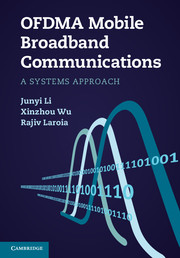Book contents
- Frontmatter
- Dedication
- Contents
- Foreword
- Preface
- List of Notation
- List of Abbreviations
- 1 Introduction
- 2 Elements of OFDMA
- 3 System design principles
- 4 Mitigation and exploitation of multipath fading
- 5 Intra-cell user multiplexing
- 6 Inter-cell interference management
- 7 Use of multiple antennas
- 8 Scheduling
- 9 Handoff in IP-based network architecture
- 10 Beyond conventional cellular frameworks
- A Overview of system operations
- B OFDM point-to-point communications
- C Brief review of channel capacity
- References
- Index
7 - Use of multiple antennas
Published online by Cambridge University Press: 05 July 2013
- Frontmatter
- Dedication
- Contents
- Foreword
- Preface
- List of Notation
- List of Abbreviations
- 1 Introduction
- 2 Elements of OFDMA
- 3 System design principles
- 4 Mitigation and exploitation of multipath fading
- 5 Intra-cell user multiplexing
- 6 Inter-cell interference management
- 7 Use of multiple antennas
- 8 Scheduling
- 9 Handoff in IP-based network architecture
- 10 Beyond conventional cellular frameworks
- A Overview of system operations
- B OFDM point-to-point communications
- C Brief review of channel capacity
- References
- Index
Summary
In general, the use of multiple antennas provides three types of gains: diversity gain, power/SINR gain (including interference suppression), and multiplexing (bandwidth or degree of freedom) gain. In Chapter 4, we studied the first two and learned that
• Antenna diversity changes the channel statistics and reduces the probability of the channel being in a deep fade, thereby improving the link reliability. Receive diversity is relatively easy to obtain. With space-time coding, transmit diversity can be achieved without the transmitter knowing the channel.
• Beamforming achieves power/SINR gain by increasing signal power and/or reducing interference. Maximal ratio combining is commonly used for receive beamforming and is applicable for transmit beamforming if the channel is known at the transmitter. Without precise channel knowledge, transmit beamforming is not possible in a single user link, but can be opportunistically achieved in a multiuser system with multiple receivers and limited SINR feedback. Power/SINR gain is mostly beneficial in the low SINR regime.
In general, the three types of gains can be simultaneously obtained, but there is a tradeoff of how much of each type a given communication scheme can achieve. A well-known example is the fundamental tradeoff of diversity and multiplexing studied in [186]. For the sake of simplicity, we focus on multiplexing gain in this chapter, and do not address the tradeoff.
- Type
- Chapter
- Information
- OFDMA Mobile Broadband CommunicationsA Systems Approach, pp. 239 - 281Publisher: Cambridge University PressPrint publication year: 2013



